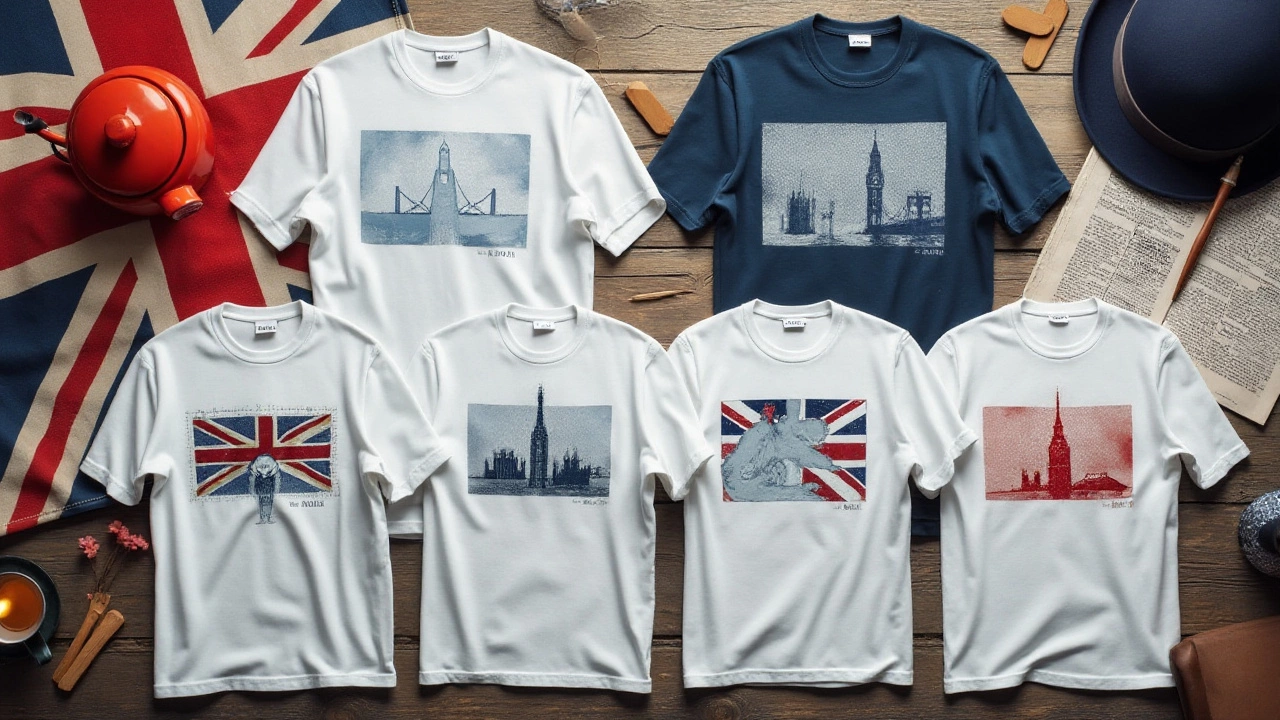When it comes to finding the perfect fit, t-shirt sizes for men can sometimes feel as mystifying as a weather forecast in Yorkshire – unpredictable and ever-changing. Though it might seem simple, choosing the correct size involves understanding various nuances like body build, fit preferences, and the unique quirks of different brands.
For many, finding a t-shirt that fits just right is akin to finding the holy grail. Whether you're on the larger end of the spectrum or prefer a snug, fitted look, knowing what constitutes a standard size could simplify things greatly. Within this guide, we'll explore how individual preferences and sizing standards converge to make the art of picking a shirt size an intriguing endeavor.
The quest for the perfect t-shirt is not solely about numbers and letters. It's about comfort, confidence, and feeling at ease in one's own skin. Let's take a closer look at the most common sizes, what influences these choices, and how to ensure the next shirt you buy fits like a dream.
- Why Men's Shirt Sizes Vary
- Common Size Categories
- Factors Influencing Shirt Size
- Navigating Brand-Specific Sizing
- Tips for Choosing the Right Fit
Why Men's Shirt Sizes Vary
Ever wondered why finding the perfect men's t-shirt size feels like a never-ending search? The truth is, multiple factors contribute to this elusive quest. To begin with, human bodies are as diverse as the tastes in music, meaning that no two individuals are exactly alike. Men, in general, have varied shoulder widths, chest dimensions, arm lengths, and waist sizes. This vast range of body types inevitably results in a need for multiple size options. What’s labeled as 'Medium' in one brand might not equate to another.
Then, there's the matter of brand-specific sizing. Clothing manufacturers, although often aiming to standardize, create sizes that often reflect their particular design ethos. For instance, American brands might differ noticeably in their sizing approach compared to European brands, with the latter often leaning towards a slimmer fit. Historical cultural influences play a role here too; as societies embraced different fashion ideals, this influenced what they considered a 'standard' size, leading to noticeable disparities across the globe.
Technology advances in fabric and manufacturing also contribute to size variations. With more flexible materials and innovative garment construction methods, clothing designers have the freedom to redefine how sizes fit, which sometimes leads to a shifting size chart. Fast fashion brands may prioritize cutting costs over maintaining a strict adherence to traditional sizing, resulting in what’s sometimes called 'vanity sizing'. Reportedly, this phenomenon allows people to feel more satisfied when they 'fit' into a smaller size than expected.
Let's not forget the input from the fashion industry itself. Industry trends urge consumers towards certain fits — from slim-fit to oversized looks — influencing how brands label their products. As consumer preferences evolve, so does the interpretation of what a 'fit' size means. In a survey conducted by a leading fashion magazine, over 60% of respondents indicated that their preferred fit, whether it be relaxed or fitted, directly impacts the size they choose to purchase.
According to renowned fashion analyst, Jean Smith, 'The complexity of garment sizing in today's market is an intersection of lasting traditionalism and new-age consumerism, where both form and comfort battle for place at the top.'It is intriguing how external forces such as pop culture trends, advertisement, and personal lifestyle choices become factors reshaping men's t-shirt sizing perspectives. In conclusion, the landscape of men’s sizing is influenced by a multitude of elements, culminating in a diverse range of interpretations that challenge standardization.
Common Size Categories
When dissecting the myriad of men's t-shirt sizes, it's essential to recognize the most prevalent categories. While the intricacies of choosing the right size may seem daunting, breaking it down by the most common categories can make the process more accessible to all. Typically, men’s t-shirts are categorized into five core sizes, each accommodating a range of shapes and personal fit preferences. These categories—small, medium, large, extra-large, and double extra-large—serve as a standard reference across many clothing retailers. But within these broad strokes lies the true complexity of finding the right fit.
Small sizes often cater to slimmer, more petite builds or those who prefer a form-fitting outline. The chest circumference for small sizes usually spans 34 to 36 inches, providing a snug fit that complements a lean physique. Medium sizes, one of the most popular among men, typically measure at a chest circumference of 38 to 40 inches. This size appeals to those who prefer a balanced fit that isn’t too tight nor too loose and suits an average male build. On the larger end, the large and extra-large sizes accommodate a broader range of body types. Large sizes generally cover a chest measurement of 42 to 44 inches, appealing to those who favor a roomier fit. Extra-large, reserved for broader shoulders and statuesque frames, often cater to those with chests measuring 46 to 48 inches.
For many retailers, double extra-large sizes are gaining popularity as the conversation surrounding body positivity and inclusivity expands. This size, accommodating chest measurements of 50 inches or more, ensures that more individuals can find a comfortable and stylish option. In a recent survey conducted by a prominent fashion magazine, it was reported that over 30% of men prefer large to extra-large sizes, reinforcing the trend towards comfort and ease in apparel.
"Understanding the sizing nuances allows us to cater to everyone, ensuring that all feel represented and comfortable in their choice of clothing," says a representative from a leading fashion label.
Size categories, while establishing a baseline, are influenced by a myriad of factors including regional differences, brand-specific tailoring, and seasonal trends. Thus, while a medium in one brand may perfectly fit, it might not translate the same way across different outlets. Modern fashion, thankfully, is evolving. Many brands are making strides towards standardizing size categories further, using more inclusive terminologies like slim-fit, classic-fit, and relaxed-fit to provide more detailed insights. By allowing for individual variations, these terms give the wearer a better understanding of how a t-shirt might sit across their particular frame.

Factors Influencing Shirt Size
Shirt size can be a tricky thing to navigate, primarily because so many factors come into play when determining the best fit. A primary consideration is body type, which varies widely among men. Whether you're shopping for a tighter fit that highlights a muscular build or seeking that relaxed drape often preferred by those seeking comfort, knowing one's own shape is key. There is a famous saying by fashion expert Tim Gunn that goes,
"Fit is the first step in achieving style, and knowing your size is where it all begins."This resonates, as the first point of measure is the build.
Next up is the style and purpose of the t-shirt. Some men prefer a more tailored look while others go for function over fashion, opting for a looser fit for sports or as laid-back weekend wear. This preference significantly impacts size selection. It's important to consider fabric composition as well! Fabrics like cotton or linen may shrink, altering the fit post-wash, while synthetic blends maintain their dimensions better over time. Clothing manufacturers often include care instructions that are worth paying attention to before deciding on size.
Then there’s the often underestimated factor of cultural and regional differences in sizing standards. European brands, for instance, might fit differently compared to American or Asian sizes. This is not solely about numbers and labels but reflects different manufacturing philosophies and body shape assumptions present across the globe. For those purchasing across borders, a keen eye on the conversion charts offered by retailers can save many a return. Here's a small tidbit for your wardrobe planning: a study conducted in 2023 revealed that over 60% of online clothing returns were due to sizing issues.
Moving onto brand-specific cuts, it becomes apparent how companies design their sizes to fit their targeted demographics. {@keywords}-focused brands often produce varied sizes depending on the expected body shape of their customer base. Therefore, understanding which brands cater to your personal needs is not just practical, but crucial for satisfaction in the long run. Lastly, don't forget to factor in personal body changes - weight fluctuations can affect shirt preference. It's often wise to reassess one's wardrobe periodically to ensure all those favorite items still live up to your sartorial expectations.
When sizing up these factors, the journey to finding the right t-shirt becomes both a science and art. Ultimately, the choice lays in what feels right, looks good, and brings joy to the wearer. Practical decisions made today can foster a stylish and sustainable wardrobe tomorrow.
Navigating Brand-Specific Sizing
Venturing into the realm of men's t-shirts often leads shoppers to discover the enigma that is brand-specific sizing. This challenge is marked by the often surprising variations in measurements and fits across different brands. For instance, what might be a medium fit in one brand could swim on you in another, transforming what should be a simple choice into an unexpectedly intricate decision-making process.
Every brand meticulously creates its own sizing blueprint, influenced by their target audience's demographic, preferences, and even regional style trends. These blueprints may be based on data collected from diverse focus groups or historical sales data that highlight popular sizes. A brand like H&M may exhibit a slimmer European fit, whereas a brand such as American Eagle may cater to a more relaxed, American fit. This divergence in sizing tips can leave the uninitiated confused and in need of guidance.
For those who wonder why they cannot seamlessly transition between brands without fit issues, it's essential to understand the personal identities brands project. These identities not rarely develop into loyal customer bases that shun other brands due to the comfort and body confidence they feel in their preferred brand's clothes. Therefore, a broad comprehension of each brand's shirt size guide is crucial. Investing time in trying on clothes from different manufacturers can prove invaluable in the long haul.
"A garment size is never a translation of your body size; it's more about how designers envision the clothing's form," remarked fashion historian Amber Butchart in 2023. Brands accordingly align these visions with their product lines, ensuring each collection stays true to their overall design philosophy.
Decoding Sizing Charts
To successfully interpret these varying sizing charts, consumers need to equip themselves with accurate body measurements. Typically, a comprehensive approach would begin with gauging chest, waist, and shoulder breadth. With these parameters, you can then align your figures against the sizing chart provided by your chosen brand. A reliable method is to directly measure a comfortable shirt from your wardrobe to compare dimensions, verifying both width and length. These numbers can then be juxtaposed with the brand's bespoke guides to identify your most suitable fit.
Certain brands provide augmented sizing guidelines on their websites or in-store cards, sparing a hectic trial-and-error fitting room experience. Cross-referencing these specifics helps inform a more calibrated purchase, minimizing instances of buyer's remorse. Keep in mind that season collections can slightly alter the measurements. Seasonal materials or cuts might usher minor adjustments to accommodate the trends in warmer months or layers in colder seasons.
It's prudent to remain updated with the fashion advice offered directly on brand sites or through reputable fashion blogs, where experienced reviewers dissect the fit and wearability of each line. Leveraging customer reviews about fit anomalies may also offer invaluable insights. A review exposing oversized arms or constrictive necklines can steer you towards reevaluating your choice, ensuring your investment leads to satisfaction.

Tips for Choosing the Right Fit
Choosing the perfect t-shirt is more art than science, and it's easy to feel overwhelmed with options. But fear not, understanding a few key points can simplify the decision-making process. Begin with the basics – your body type, personal style preferences, and how you like your t-shirts to fit. Are you a fan of the relaxed style, or do you prefer a snug men's t-shirt that accentuates your physique? Once your style direction is clear, measuring correctly is crucial. Arm yourself with a tape measure and ensure you're aware of your chest, waist, and shoulder widths. With these measurements, you can easily navigate sizing charts provided by most brands, ensuring that you pick the size that's closest to your measurements.
Now, you might think all brands adhere to a standard. But much like the vibrant streets of York, each brand has its own vibe. Before purchasing, always check the brand’s specific measurements. Some brands lean toward a slimmer cut, which brings us to our next consideration – the style of the t-shirt. Different styles serve different purposes, from crew necks for casual hangouts to v-necks that offer a touch of sophistication.
According to Susan H. of Vogue UK, "Understanding your body shape and the nuances of different brands can transform anyone into a savvy t-shirt shopper."So, when you step into a store, feel the fabric and consider its stretchability and thickness. These can dictate whether the piece will maintain its shape or ripple with every wear.
Color and material are equally vital. While cotton remains a perennial favorite due to its breathability and comfort, don't shy away from trying blends that might provide additional durability and fit. Choosing colors that complement your wardrobe simplifies pairing your t-shirt with different outfits. Also, it's always wise to consider the occasion you expect to wear the shirt most. Is it for a night out, running errands, or perhaps even work? Versatility in color and fabric ensures that a single piece can satisfy multiple fashion needs.
Pay heed to aftercare and longevity. A well-fitted t-shirt that loses its luster after one wash isn't a good investment. Always refer to the care label; knowing how to launder and dry a garment can extend its life. Some fabrics might be easy maintenance, while others demand gentle cycles and air drying. Proper care not only maintains the t-shirt's quality but also its fit over time. Incorporating these mindful practices when choosing shirt sizes can make all the difference in your wardrobe's versatility and longevity.
Finally, your personal style should shine through with every purchase. Trends come and go, but your comfort and confidence are timeless. Consult friends or family who understand your style preferences if you're uncertain. They can offer valuable insight into what suits you best. Remember that the perfect fit isn’t just about measurements; it’s about finding a harmony between trend, personal taste, and practicality. Embark on this journey thoughtfully, and you'll soon find that each purchase tells a story, just like the cobblestones of York whispering history between shop vendors and wandering souls.

